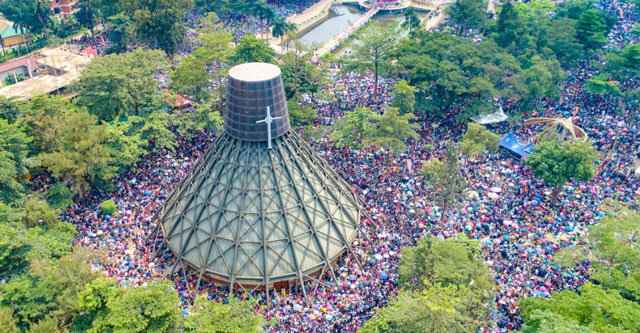
Kampala, Uganda | THE INDEPENDENT | Kampala Archdiocese has commenced festivities marking the 60th anniversary of the canonization of the Uganda Martyrs. As part of the celebrations, the Archdiocese will move the Sacred Relics of the saints in different parishes and selected catholic institutions including schools, and hospitals.
Rev Fr Richard Nyombi, the Coordinator of the Society of Missionaries of Africa in Uganda, noted that the move was launched last year but has officially kicked off with the relics being moved in parishes that make up Mitala Maria Deanery.
Speaking about the diamond jubilee preparations, Nyombi said that from Mitala Maria, the relics will be moved and reach all the 75 parishes that makeup Kampala Archdiocese and other selected catholic institutions.
As the martyrs’ relics traverse various locations, the faithful are anticipated to reflect on the steadfast faith of the Uganda Martyrs, aiming to renew their commitment under the theme; We the baptized, let us journey together in communion, participation, and mission in the footsteps of the Uganda martyrs.
In the Catholic faith, relics connect believers to saints. There are three types: first-class (part of the saint’s body), second-class (items used by the saint), and third-class (objects in contact with the saint).
The Uganda Martyrs’ first-class relics, fragments of St. Charles Lwanga and St. Matia Mulumba’s bones, are revered in golden boxes. During the June 3rd mass, priests prominently display these relics, fostering a tangible connection during the procession.
Available information published in different books and retold by the clergy, the relics of the two martyrs have a historical contribution to the martyrs’ canonization. The relics are said to have been obtained from their death sites, they were buried in boxes by white fathers in Nabulagala during religious wars. The relics later could be exhumed.
In 1941, during the bubonic plague, nuns Sr. Aloyse Criblet and Sr. Richildis contracted the disease. Applying relics and prayers for nine days led to their recovery in three days. In 1959, Revocato Kalema, born with curved legs, found healing too in the same miraculous process at Bwanda convent.
Fr Nyombi added that after the tour, the main celebration uniting the Kampala Ecclesiastical Province (with dioceses of Masaka, Lugazi, Kiyinda-Mityana, and Kasana-Luweero) will culminate on November 15 at Munyonyo Minor Basilica.
Munyonyo holds significant importance for Catholics in Uganda. It marks the starting point for young Christians’ final journey to their execution in Namugongo on June 3, 1886. These converts, sentenced to death in Munyonyo, undertook a two-day journey to Namugongo. Some were killed in Munyonyo, others along the way, with the majority being burned alive in Namugongo on June 3rd.
The death of the martyrs initially termed the “black/African holocaust”, became a cornerstone of Catholicism in Uganda. In 1920, Pope Benedict XV took a significant step toward their future canonization, declaring the 13 known Catholic martyrs killed at Namugongo, along with nine other victims from separate incidents between 1885 and 1887, as “blessed.”
On October 18, 1964, Pope Paul VI canonized all 22 martyrs in St. Peter’s Basilica in Rome during the Second Vatican Council. He officially declared them saints, designating June 3 as the day for global observance of their martyrdom. In an extraordinary gesture, Paul VI, in July 1969, became the first reigning Pope to visit sub-Saharan Africa, including a pilgrimage to the Namugongo martyrdom site, further honoring these African saints. Since then, two other Popes have visited the shrine.
Uganda Episcopal Conference Chairperson, Rt. Rev. Joseph Antony Zziwa stated that in addition to the celebrations announced by the Kampala Archdiocese, the official nationwide commemoration in Uganda will take place on June 3rd. Nebbi Diocese will organize the event at the Namugongo Martyrs Shrine.
Bishop Zziwa, also the ordinary of Kiyinda-Mityana Diocese, underscored that celebrations at various levels will continue, with each diocese or province making independent arrangements to honor the Uganda Martyrs.
The Uganda Martyrs hold a prominent place among Catholic martyrs globally. They are immortalized through various means, such as the naming of parishes after them, using their collective or individual names, and dedicating streets, buildings, and schools in their memory. Additionally, newborns are named after them, and their legacy is celebrated in songs and various other ways.
The significance of the 22 martyrs, now saints, attracts pilgrims and tourists from both within Uganda and from outside the country every year.
****
URN
 The Independent Uganda: You get the Truth we Pay the Price
The Independent Uganda: You get the Truth we Pay the Price



